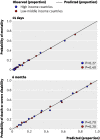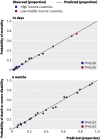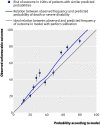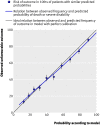Predicting outcome after traumatic brain injury: practical prognostic models based on large cohort of international patients
- PMID: 18270239
- PMCID: PMC2249681
- DOI: 10.1136/bmj.39461.643438.25
Predicting outcome after traumatic brain injury: practical prognostic models based on large cohort of international patients
Abstract
Objective: To develop and validate practical prognostic models for death at 14 days and for death or severe disability six months after traumatic brain injury.
Design: Multivariable logistic regression to select variables that were independently associated with two patient outcomes. Two models designed: "basic" model (demographic and clinical variables only) and "CT" model (basic model plus results of computed tomography). The models were subsequently developed for high and low-middle income countries separately.
Setting: Medical Research Council (MRC) CRASH Trial.
Subjects: 10,008 patients with traumatic brain injury. Models externally validated in a cohort of 8509.
Results: The basic model included four predictors: age, Glasgow coma scale, pupil reactivity, and the presence of major extracranial injury. The CT model also included the presence of petechial haemorrhages, obliteration of the third ventricle or basal cisterns, subarachnoid bleeding, midline shift, and non-evacuated haematoma. In the derivation sample the models showed excellent discrimination (C statistic above 0.80). The models showed good calibration graphically. The Hosmer-Lemeshow test also indicated good calibration, except for the CT model in low-middle income countries. External validation for unfavourable outcome at six months in high income countries showed that basic and CT models had good discrimination (C statistic 0.77 for both models) but poorer calibration.
Conclusion: Simple prognostic models can be used to obtain valid predictions of relevant outcomes in patients with traumatic brain injury.
Conflict of interest statement
Competing interests: None declared.
Figures







Comment in
-
Prognostic modelling in traumatic brain injury.BMJ. 2008 Feb 23;336(7641):397-8. doi: 10.1136/bmj.39461.616991.80. Epub 2008 Feb 12. BMJ. 2008. PMID: 18270240 Free PMC article.
-
Traumatic brain injury: Time of hospital presentation may be important.BMJ. 2008 Mar 8;336(7643):522. doi: 10.1136/bmj.39507.481840.80. BMJ. 2008. PMID: 18325947 Free PMC article. No abstract available.
Similar articles
-
Validation of a prognostic score for early mortality in severe head injury cases.J Neurosurg. 2014 Dec;121(6):1314-22. doi: 10.3171/2014.7.JNS131874. Epub 2014 Sep 19. J Neurosurg. 2014. PMID: 25237737
-
Predicting intracranial hemorrhage after traumatic brain injury in low and middle-income countries: a prognostic model based on a large, multi-center, international cohort.BMC Emerg Med. 2012 Nov 19;12:17. doi: 10.1186/1471-227X-12-17. BMC Emerg Med. 2012. PMID: 23157693 Free PMC article.
-
Predicting outcomes after traumatic brain injury: the development and validation of prognostic models based on admission characteristics.J Trauma Acute Care Surg. 2012 Jul;73(1):137-45. doi: 10.1097/TA.0b013e31824b00ac. J Trauma Acute Care Surg. 2012. PMID: 22743383
-
Systematic review of prognostic models in traumatic brain injury.BMC Med Inform Decis Mak. 2006 Nov 14;6:38. doi: 10.1186/1472-6947-6-38. BMC Med Inform Decis Mak. 2006. PMID: 17105661 Free PMC article. Review.
-
Prognostic Value of CRASH and IMPACT Models for Predicting Mortality and Unfavorable Outcome in Traumatic Brain Injury; a Systematic Review and Meta-Analysis.Arch Acad Emerg Med. 2023 Mar 4;11(1):e27. doi: 10.22037/aaem.v11i1.1885. eCollection 2023. Arch Acad Emerg Med. 2023. PMID: 36919143 Free PMC article. Review.
Cited by
-
Fluid Biomarkers of Traumatic Brain Injury and Intended Context of Use.Diagnostics (Basel). 2016 Oct 18;6(4):37. doi: 10.3390/diagnostics6040037. Diagnostics (Basel). 2016. PMID: 27763536 Free PMC article. Review.
-
Matrix metalloproteinase 9 and cellular fibronectin plasma concentrations are predictors of the composite endpoint of length of stay and death in the intensive care unit after severe traumatic brain injury.Scand J Trauma Resusc Emerg Med. 2012 Dec 18;20:83. doi: 10.1186/1757-7241-20-83. Scand J Trauma Resusc Emerg Med. 2012. PMID: 23249478 Free PMC article.
-
Validation of CRASH Model in Prediction of 14-day Mortality and 6-month Unfavorable Outcome of Head Trauma Patients.Emerg (Tehran). 2016 Nov;4(4):196-201. Emerg (Tehran). 2016. PMID: 27800540 Free PMC article.
-
Prediction of motor function in patients with traumatic brain injury using genetic algorithms modified back propagation neural network: A data-based study.Front Neurosci. 2023 Jan 19;16:1031712. doi: 10.3389/fnins.2022.1031712. eCollection 2022. Front Neurosci. 2023. PMID: 36741050 Free PMC article.
-
A Novel Blood Inflammatory Indicator for Predicting Deterioration Risk of Mild Traumatic Brain Injury.Front Aging Neurosci. 2022 Apr 26;14:878484. doi: 10.3389/fnagi.2022.878484. eCollection 2022. Front Aging Neurosci. 2022. PMID: 35557838 Free PMC article.
References
-
- Bruns J Jr, Hauser WA. The epidemiology of traumatic brain injury: a review. Epilepsia 2003;44(suppl 10):2-10. - PubMed
-
- Perel P, Wasserberg J, Ravi RR, Shakur H, Edwards P, Roberts I. Prognosis following head injury: a survey of doctors from developing and developed countries. J Eval Clin Pract 2007;13:464-5. - PubMed
-
- Lee KL, Pryor DB, Harrell FE Jr, Califf RM, Behar VS, Floyd WL, et al. Predicting outcome in coronary disease. Statistical models versus expert clinicians. Am J Med 1986;80:553-60. - PubMed
Publication types
MeSH terms
LinkOut - more resources
Full Text Sources
Other Literature Sources
